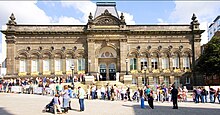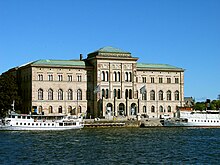Libraries
Among the Texas A&M Libraries are:
- Sterling C. Evans Library and Library Annex -- The general academic library containing the bulk of the library collections and services, including access services, interlibrary loan, consolidated reference, current periodicals and course reserves, United States and Texas government documents, audiovisual and media services, reading and study rooms, the map room, and the Administrative Offices.

- Cushing Memorial Library and Archives -- Constructed in 1930, it was the first freestanding library facility on campus and is now home to special collections, rare books, and the University Archives. The collections span recorded history, from Sumerian clay tablets dating from 2400 BCE to contemporary science fiction paperbacks. These collections comprise over 22,000 feet (6,700 m) of manuscript and archival material, approximately 200,000 printed volumes, 400,000 photographs, hundreds of original works of art ranging from oil paintings to pastels to sculpture, and many individual artifacts. The collections include works on paper, film, tape, CD, and other media. Collection strengths and interests of the Cushing Library include military history, science fiction, western Americana, 19th-century American prints and illustrators, modern politics, Texana, natural history, Africana, Hispanic studies, ornithology, nautical archaeology, 18th-century French history and culture, Mexican colonial history, the history of books and printing, the history of Texas A&M, and selected literary collections. Historic images and photographs of the Texas A&M community are available from the Historic Images Collection.

- Medical Sciences Library -- The Medical Sciences Library serves as the primary library for the undergraduate, graduate and professional programs in the College of Veterinary Medicine and Biomedical Sciences , the College of Agriculture and Life Sciences, and the Texas A&M University Health Science Center. The Medical Sciences Library also serves as a resources library for Texas Veterinarians and TAMU College of Veterinary Medicine alumni. In addition, the library contracts with the National Library of Medicine's Regional Medical Library to perform outreach services to area hospitals, clinics and practitioners in a 22 county area, and maintains two National Library of Medicine Go Local websites, Heart of Texas and East Texas Connect to serve the needs of Texas health care consumers.

- Policy Sciences and Economics Library -- Located at the Annenberg Presidential Conference Center, the Policy Sciences & Economics Library provides library resources and services to the Department of Economics, the Department of Political Science, and the George Bush School of Government and Public Service.
- Qatar Library -- Texas A&M University has initiated a program of study in the emerging nation of Qatar. A focused and growing library supports the four engineering disciplines: chemical, electrical, mechanical, and petroleum and the liberal arts subject areas required for these degrees. In addition to managing information resources, the library provides service and support to a multinational student body and faculty researchers as well as the local community of oil/gas industry specialists. Built on the vast collection of the home campus library system, the library integrates a small but core collection of print books, journals and audiovisual materials with a large body of electronic resources.

- TxSpace: TAMU Digital Repository -- TxSpace is the Texas A&M Institutional Repository, holding collections ranging from electronic theses and dissertations to Humanities Informatics video lectures. The repository, which stores materials born in digital format, is intended to preserve and make accessible faculty research and publications. It also houses faculty manuscripts, technical reports, collections from Cushing Library including selected colonial Mexican items, and more.
- West Campus Library – Providing library resources and services to the Mays Business School, WCL offers specialized collections of current periodicals, reference works, and monographs in business and agriculture. It houses the patent and trademark depository. In addition to its collections, the WCL is open 24/5 – from 1 p.m. Sundays through 10 p.m. Fridays – to meet the needs of students who increasingly stay late to do research and reading for their classes, as well as work on projects.
















